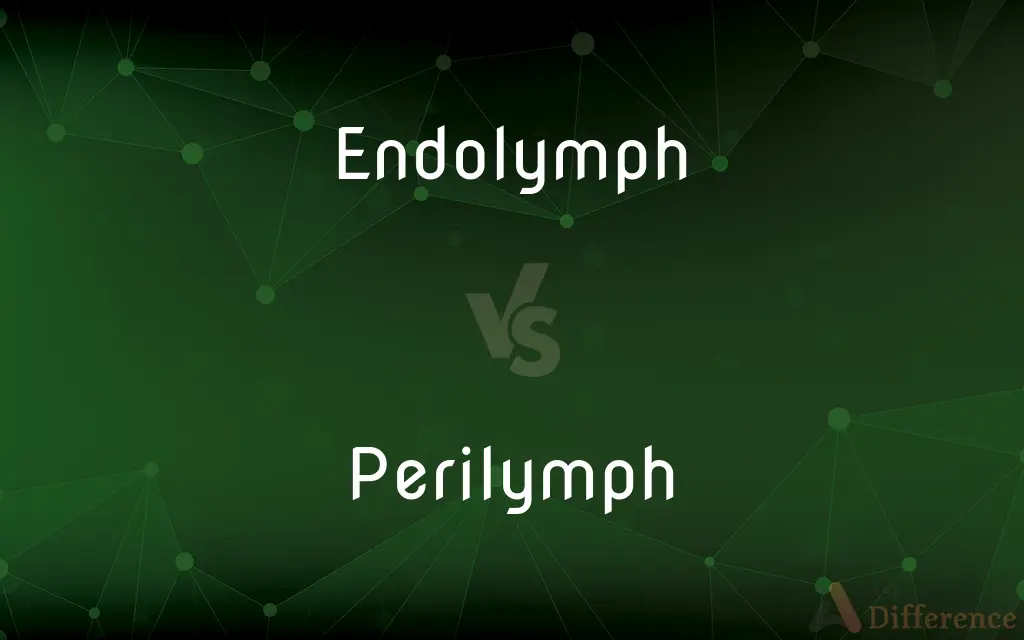Endolymph vs. Perilymph — What's the Difference?
Edited by Tayyaba Rehman — By Fiza Rafique — Updated on October 10, 2023
Endolymph is the fluid inside the membranous labyrinth of the inner ear; Perilymph is the fluid between the membranous and bony labyrinths.

Difference Between Endolymph and Perilymph
Table of Contents
ADVERTISEMENT
Key Differences
Endolymph and Perilymph are both crucial fluids found within the inner ear, serving distinct roles in the process of hearing and balance. Endolymph is the fluid that fills the membranous labyrinth, a complex system of tubes and sacs in the inner ear. This fluid plays a direct role in translating the vibrations from sound waves into signals that the brain interprets as sound. On the other hand, Perilymph surrounds the membranous labyrinth, filling the space between it and the bony labyrinth.
The composition of both Endolymph and Perilymph is different, affecting their respective functions. Endolymph has a higher concentration of potassium ions compared to sodium ions. This ionic composition aids in the generation of electrical potentials necessary for the transmission of auditory signals. In contrast, Perilymph, with its higher concentration of sodium ions than potassium ions, provides an electrically appropriate environment and cushions the membranous labyrinth.
It's vital to understand the positioning of Endolymph and Perilymph to appreciate their roles. Endolymph can be found in structures like the cochlea's scala media and the vestibular apparatus, directly involved in sensing sound and maintaining balance. Perilymph, residing in spaces like the scala tympani and scala vestibuli of the cochlea, provides a protective buffer and maintains the ionic balance essential for the proper functioning of the inner ear.
Both Endolymph and Perilymph serve as protective agents for the delicate structures of the inner ear. While Endolymph ensures that hair cells, essential for hearing, function properly by maintaining an appropriate ionic environment, Perilymph acts as a cushion, protecting the membranous labyrinth from potential damage and ensuring its structural integrity.
In essence, both Endolymph and Perilymph are integral to the auditory system's function, with each fluid having its unique role. While Endolymph is involved more directly in the conversion of vibrations to electrical signals, Perilymph provides a conducive environment for this process and offers protection to the delicate structures of the inner ear.
ADVERTISEMENT
Comparison Chart
Location
Inside the membranous labyrinth
Between the membranous and bony labyrinths
Ionic Composition
Higher concentration of potassium ions
Higher concentration of sodium ions
Function
Translates vibrations to electrical signals
Provides cushioning and maintains ionic balance
Found in Structures
Scala media, vestibular apparatus
Scala tympani, scala vestibuli
Role in Inner Ear
Directly involved in hearing and balance
Protects and maintains environment for membranous labyrinth
Compare with Definitions
Endolymph
Endolymph is the fluid filling the inner ear's membranous labyrinth.
Vibrations in the Endolymph help us perceive sound.
Perilymph
Perilymph is the fluid surrounding the membranous labyrinth in the inner ear.
The Perilymph acts as a cushion, protecting the inner ear's delicate structures.
Endolymph
Endolymph maintains the functionality of the hair cells in the ear.
Proper flow of Endolymph ensures the health of sensory hair cells.
Perilymph
Perilymph resides between the bony and membranous labyrinths.
Damage to the inner ear can cause mixing of Endolymph and Perilymph.
Endolymph
Endolymph plays a crucial role in maintaining balance.
Movements of Endolymph in the vestibular system help us sense our body's position.
Perilymph
Perilymph provides a conducive environment for the inner ear's functioning.
The Perilymph maintains an ionic balance vital for hearing.
Endolymph
Endolymph contains a high concentration of potassium ions.
The ionic composition of Endolymph is essential for auditory signal transmission.
Perilymph
Perilymph protects and supports the inner ear's membranous structures.
Without Perilymph, the membranous labyrinth would be susceptible to damage.
Endolymph
Endolymph is vital for translating sound vibrations into electrical signals.
Disruptions in Endolymph can impair hearing and balance.
Perilymph
Perilymph contains a higher concentration of sodium ions.
The ionic environment of Perilymph ensures proper inner ear functioning.
Endolymph
Endolymph is the fluid contained in the membranous labyrinth of the inner ear. The major cation in endolymph is potassium, with the values of sodium and potassium concentration in the endolymph being 0.91 mM and 154 mM, respectively.
Perilymph
Perilymph is an extracellular fluid located within the inner ear. It is found within the scala tympani and scala vestibuli of the cochlea.
Endolymph
The fluid in the membranous labyrinth of the inner ear.
Perilymph
The fluid in the space between the membranous and bony labyrinths of the inner ear.
Endolymph
(anatomy) The watery fluid inside the membranous labyrinth of the inner ear.
Perilymph
An extracellular fluid found in the scala tympani and scala vestibuli of the cochlea.
Endolymph
The watery fluid contained in the membranous labyrinth of the internal ear.
Perilymph
The fluid which surrounds the membranous labyrinth of the internal ear, and separates it from the walls of the chambers in which the labyrinth lies.
Endolymph
The bodily fluid that fills the membranous labyrinth of the inner ear
Perilymph
The bodily fluid that fills the space between the bony labyrinth and the membranous labyrinth of the inner ear
Common Curiosities
Can disruptions in Perilymph affect hearing?
Yes, disruptions in Perilymph can impair the conducive environment necessary for the proper functioning of the inner ear and hearing.
Where is Endolymph located in the ear?
Endolymph is located inside the membranous labyrinth of the inner ear.
Why is Endolymph crucial for hearing?
Endolymph plays a direct role in translating sound wave vibrations into signals the brain interprets as sound.
What happens if Endolymph and Perilymph mix?
Mixing of Endolymph and Perilymph can lead to a condition called endolymphatic hydrops, often associated with Ménière's disease.
How does the ionic composition of Endolymph differ from Perilymph?
Endolymph has a higher concentration of potassium ions, while Perilymph has a higher concentration of sodium ions.
What ensures the separation of Endolymph and Perilymph?
The membranous labyrinth ensures that Endolymph and Perilymph remain separated in the inner ear.
What is the primary role of Perilymph?
Perilymph cushions the membranous labyrinth and maintains the ionic balance essential for the inner ear's proper function.
What structures in the ear contain Endolymph?
Endolymph is found in structures like the scala media of the cochlea and the vestibular apparatus.
Are both Endolymph and Perilymph unique to humans?
No, both Endolymph and Perilymph are found in the inner ears of many vertebrates.
Can disorders related to Endolymph cause vertigo?
Yes, disorders affecting Endolymph, like Ménière's disease, can result in vertigo.
How does Perilymph protect the inner ear?
Perilymph acts as a cushion, providing protection to the membranous labyrinth from potential damage.
How is Endolymph related to balance?
Movements of Endolymph in the vestibular system of the ear help in sensing balance and body position.
How do the functions of Endolymph and Perilymph differ?
While Endolymph is directly involved in converting vibrations to electrical signals, Perilymph provides a conducive environment and offers protection to the inner ear structures.
How is the ionic composition of Perilymph important?
The ionic composition of Perilymph, especially its high sodium concentration, ensures the proper electrical environment for the inner ear's function.
Is the volume of Endolymph constant in the ear?
Typically, yes, but certain conditions can lead to an excessive buildup of Endolymph, causing issues like vertigo and hearing loss.
Share Your Discovery

Previous Comparison
Unit vs. Team
Next Comparison
PST vs. MSTAuthor Spotlight
Written by
Fiza RafiqueFiza Rafique is a skilled content writer at AskDifference.com, where she meticulously refines and enhances written pieces. Drawing from her vast editorial expertise, Fiza ensures clarity, accuracy, and precision in every article. Passionate about language, she continually seeks to elevate the quality of content for readers worldwide.
Edited by
Tayyaba RehmanTayyaba Rehman is a distinguished writer, currently serving as a primary contributor to askdifference.com. As a researcher in semantics and etymology, Tayyaba's passion for the complexity of languages and their distinctions has found a perfect home on the platform. Tayyaba delves into the intricacies of language, distinguishing between commonly confused words and phrases, thereby providing clarity for readers worldwide.














































